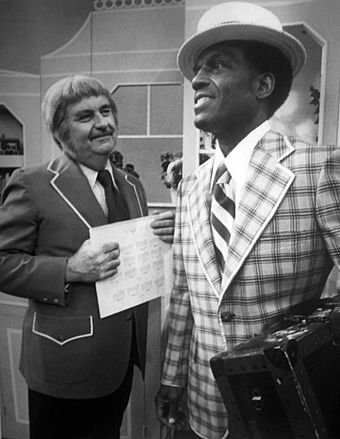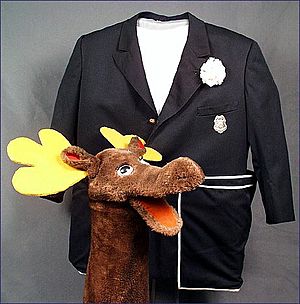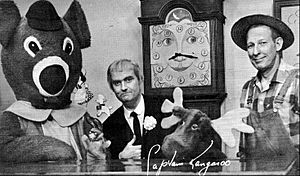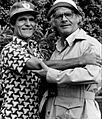Captain Kangaroo facts for kids
Quick facts for kids Captain Kangaroo |
|
|---|---|

Captain Kangaroo (Bob Keeshan), left, with Nipsey Russell, 1976
|
|
| Created by | Bob Keeshan |
| Written by | Howard Friedlander |
| Starring | Bob Keeshan Hugh Brannum |
| Opening theme | "Puffin' Billy (The Captain Kangaroo Theme)" (1955–1974) "Good Morning, Captain" (1974–1984) |
| Country of origin | United States |
| No. of seasons | 29 |
| No. of episodes | 6,090 |
| Production | |
| Running time | 60 minutes / 30 minutes |
| Release | |
| Original network | CBS |
| Original release | October 3, 1955 – December 8, 1984 |
Captain Kangaroo was a popular American children's television series. It aired weekday mornings on the CBS network for 29 years. The show ran from 1955 to 1984. This made it one of the longest-running children's TV programs of its time. Later, from 1986 to 1993, older episodes with some new parts were shown on PBS.
Bob Keeshan created the show and played the main character, "Captain Kangaroo." He wanted the show to feel like the warm bond between grandparents and children. Before this, Keeshan played Clarabell the Clown on The Howdy Doody Show. Captain Kangaroo was set in the "Treasure House." The Captain (whose name came from the big pockets in his coat) would tell stories. He also met guests and did funny things with human and puppet friends. Bob Keeshan played the Captain over 9,000 times!
On May 17, 1971, the show changed. The Treasure House was updated and called "The Captain's Place." The Captain also changed his navy blue coat to a red one. In September 1981, CBS made the show shorter, from an hour to 30 minutes. It was briefly called Wake Up with the Captain and moved to an earlier time. In September 1982, it moved to weekends and became an hour long again. CBS stopped airing Captain Kangaroo at the end of 1984.
Contents
Meet the Cast of Captain Kangaroo
- Bob Keeshan played Captain Kangaroo. He also played Mr. Pennywhistle, Mr. Doodle, Wally, and the Town Clown.
- Hugh "Lumpy" Brannum played Mr. Green Jeans. He also played the New Old Folk Singer, Percy, Uncle Backwards, Mr. McGregor, and Mr. Bainter the Painter.
- Cosmo Allegretti brought many characters to life. He created and played Mr. Bunny Rabbit and Mr. Moose. He also played Dennis the Apprentice, Willy, Miss Frog, Mr. Whispers, Dancing Bear, Grandfather Clock, and Uncle Ralph. Cosmo was the voice of TV Fred and the artist behind the Magic Drawing Board.
- Sam Levine played The Banana Man.
- Bill Cosby hosted the Picture Pages part of the show from 1980 to 1984.
- Debbie Weems played Debbie from 1973 to 1978. She was also the voice for the puppet Baby Duck.
- James Wall played Mr. Baxter from 1968 to 1978.
- Carolyn Mignini played Kathy and other female roles from 1981 to 1983.
- Kevin Clash played the puppet Artie from 1980 to 1984. He also acted in many sketches.
- John Burstein played Slim Goodbody from 1978 to 1981.
- Bill McCutcheon played Mr. Homan from 1965 to 1968.
- Jane Connell played Mrs. Homan from 1965 to 1968.
- Dr. Joyce Brothers appeared as herself for three seasons.
Show Format and Fun Segments

Captain Kangaroo didn't have a super strict plan for each episode. The whole show happened in or around the Treasure House or the Captain's Place. The Captain would talk with puppets, guests, or other cast members. Even the beginning of the show could change!
Usually, the show started with music. Then the Captain would open the Treasure House doors from the inside. He would hang his keys on a nail, and the music would stop. But sometimes, the keys would fall off, and the music would start playing again! You never knew exactly what would happen. Around Christmas, they often showed paper cutout stories like The Littlest Snowman.
Awesome Cartoons on the Show
Many different cartoons were shown during the series.
- A cartoon about a boy named Tom Terrific was popular in the 1950s and 1960s. Tom could change shapes and had a dog sidekick named Mighty Manfred. His enemy was Crabby Appleton, who always said, "I'm rotten to the core!"
- Lariat Sam was another cartoon. He and his horse, Tippytoes, faced off against Badlands Meanie.
- The British cartoon Simon in the Land of Chalk Drawings appeared in the 1970s. Simon had magic chalk and could draw things that came to life for short adventures.
- Another British cartoon was Ludwig, about a magical egg-shaped robot. The music for this cartoon was from Beethoven.
- The Most Important Person was a series of short segments. They taught kids about the importance of life.
- The Toothbrush Family cartoon was about a family of hygiene tools. They had adventures in the bathroom and taught kids about dental care.
- Crystal Tipps and Alistair was a silent cartoon about a girl and her dog. Later, Mr. Moose narrated it.
- The Wombles, another British favorite, was also featured.
- The Red and the Blue shorts from Italy were shown.
- The Undersea Adventures of Captain Nemo featured a family exploring the sea.
"Good Morning, Captain!" Greetings
Starting in 1974, the show often opened with different people wishing the Captain "good morning." Many were everyday people, but some were famous stars. These stars often came from CBS shows like The Bob Newhart Show or M*A*S*H. Even characters from other networks appeared, like William Shatner and Leonard Nimoy as Captain Kirk and Mr. Spock. Big Bird from Sesame Street and Fred Rogers from Mister Rogers' Neighborhood also said hello. The "good mornings" always ended with the Captain saying "good morning" back before the show's opening.
Regular Fun and Games
The show had many regular parts. These included The Magic Drawing Board and the Captain's "Reading Stories" time. He introduced kids to books like Curious George and Make Way for Ducklings.
The show also featured many songs. Some were original songs like "Captain Kangaroo" and "The Captain's Place." Others were well-known songs like "Supercalifragilisticexpialidocious" or "Yellow Submarine," performed by puppets. The show even played real rock songs for young viewers. On the first show of every month, the Captain had a birthday cake for all the children born that month.
Keeshan also played the Town Clown. This character was a silent circus clown who lived in a wagon. Like his character Clarabelle on Howdy Doody, the Town Clown never spoke.
Favorite puppet characters included Grandfather Clock, Bunny Rabbit, Rollo the Hippo, and Dancing Bear. Dancing Bear was silent and often danced to waltz music.
One funny ongoing joke was the "Ping-Pong Ball Drop." Mr. Moose would tell a joke, usually a knock-knock joke. When the punchline included "ping-pong balls," a shower of ping-pong balls would fall on the Captain!
The show often used simple black light theatre with paper cutouts. They would play famous songs like Judy Garland's "Over the Rainbow" while the cutouts moved. Sometimes, hand puppets would "perform" to songs.
The show also featured short film clips about different topics, set to a song about that topic. In later seasons, the Captain would try to do an activity several times in an episode, failing in a different funny way each time.
Familiar items on the show included a talking radio called Radio. Keeshan would turn its knobs to start a conversation. Another prop was a huge Colgate toothpaste box with a key. Keeshan would turn the key to play a jingle for the show's sponsor, Colgate Toothpaste.
At the end of each episode, the Captain always told parents to spend quality time with their children. He would often show fun ways to do this. In later seasons, he would say, "Well, what would you like to do today? You know it could be a good day for..." Then a song would list many activities. The song ended with, "There's so much to do. These things are just a few." The Captain would then sign off, "So whatever you do, have a great day!"
The Captain Kangaroo Theme Songs
The first theme song, "Puffin' Billy," was used from 1955 to 1974. It was an instrumental piece of light music. This tune was already popular in the United Kingdom. It was used on many shows there, including a BBC radio program called Children's Favourites. The "Puffin' Billy" theme played at the start of each episode. The music stopped when the Captain hung his keys on a nail. If the keys fell off, the music started again! In 1957, Mary Rogers wrote words for the tune, creating a new "Captain Kangaroo" song.
In 1974, a new theme song called "Good Morning, Captain" was made. Robert L. Brush wrote it. It used parts of the old theme, so Edward G. White (who wrote "Puffin' Billy") was also given credit. But because of copyright rules, the song was re-recorded in 1979 without the "Puffin' Billy" part.
For a short time, when the show was called Wake Up With the Captain, a theme called "Wake Up" was used. But when the show moved to weekends, "Good Morning, Captain" came back.
For the last seasons (1982-1984) and the PBS reruns, Lynn Ahrens wrote a new theme. It was called "Here Comes Captain Kangaroo." She also wrote and performed other songs for the show.
The theme song for a later show, All New Captain Kangaroo, used the beginning notes of the original theme.
Bob Keeshan also recorded music albums for children. He wanted to introduce kids to all kinds of music.
The 1997 Reboot of Captain Kangaroo
In 1997–1998, a new version of the show was made. It was called The All New Captain Kangaroo. John McDonough played the Captain in this version. It was filmed in Tampa, Florida, and included animal segments from Busch Gardens Tampa Bay and Seaworld in Orlando. Bob Keeshan was asked to appear as a special guest called "The Admiral," but he said no.
Thirteen episodes were made for TV stations to show. An extra twenty-seven episodes were part of a TV block called Captain Kangaroo's Treasure House on The Family Channel (later Fox Family Channel). This block also showed reruns of Thomas the Tank Engine and Friends and Magic Adventures of Mumfie. There was also a spin-off show called Mister Moose's Fun Time. This show included cartoons from around the world. When Disney bought Fox Family, they stopped showing The All New Captain Kangaroo and Mister Moose's Fun Time. This was reportedly because the reboot advertised Busch Gardens & Seaworld, which are rivals of Walt Disney World.
In 2011, the rights to Captain Kangaroo were bought by the Cashin Comedy Co. Pat Cashin, an entertainer, played the Captain in a blog. Cashin passed away in 2016, and the rights to the character stayed with his family.
Images for kids




